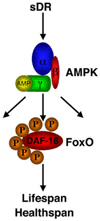AMP-activated protein kinase and FoxO transcription factors in dietary restriction-induced longevity
- PMID: 19686213
- PMCID: PMC2814416
- DOI: 10.1111/j.1749-6632.2009.04019.x
AMP-activated protein kinase and FoxO transcription factors in dietary restriction-induced longevity
Abstract
Aging is regulated by modifications in single genes and by simple changes in the environment. The signaling pathway connecting insulin to FoxO transcription factors integrates environmental stimuli to regulate lifespan. FoxO transcription factors are directly phosphorylated in response to insulin/growth factor signaling by the protein kinase Akt, thereby causing their sequestration in the cytoplasm. In the absence of insulin/growth factors, FoxO factors translocate to the nucleus where they trigger a range of cellular responses, including resistance to oxidative stress--a phenotype highly coupled with lifespan extension. Our recent results indicate that FoxO transcription factors are also regulated in response to nutrient deprivation by the AMP-activated protein kinase (AMPK) pathway. The energy-sensing AMPK directly phosphorylates FoxO transcription factors at six regulatory sites. AMPK phosphorylation enhances FoxO transcriptional activity, leading to the expression of specific target genes involved in stress resistance and changes in energy metabolism. The AMPK-FoxO pathway plays a crucial role in the ability of a dietary restriction regimen to extend lifespan in Caenorhabditis elegans. Understanding the intricate signaling networks that translate environmental conditions like dietary restriction into changes in gene expression that extend lifespan will be of critical importance to identify ways to delay the onset of aging and age-dependent diseases.
Conflict of interest statement
The authors declare no conflicts of interest.
Figures

Similar articles
-
An AMPK-FOXO pathway mediates longevity induced by a novel method of dietary restriction in C. elegans.Curr Biol. 2007 Oct 9;17(19):1646-56. doi: 10.1016/j.cub.2007.08.047. Epub 2007 Sep 27. Curr Biol. 2007. PMID: 17900900 Free PMC article.
-
FOXO transcription factors in ageing and cancer.Acta Physiol (Oxf). 2008 Jan;192(1):19-28. doi: 10.1111/j.1748-1716.2007.01780.x. Acta Physiol (Oxf). 2008. PMID: 18171426 Review.
-
Different dietary restriction regimens extend lifespan by both independent and overlapping genetic pathways in C. elegans.Aging Cell. 2009 Apr;8(2):113-27. doi: 10.1111/j.1474-9726.2009.00459.x. Epub 2009 Feb 23. Aging Cell. 2009. PMID: 19239417 Free PMC article.
-
Oxaloacetate supplementation increases lifespan in Caenorhabditis elegans through an AMPK/FOXO-dependent pathway.Aging Cell. 2009 Dec;8(6):765-8. doi: 10.1111/j.1474-9726.2009.00527.x. Epub 2009 Sep 30. Aging Cell. 2009. PMID: 19793063 Free PMC article.
-
FOXO transcription factors in the regulatory networks of longevity.J Biochem. 2007 Jun;141(6):769-74. doi: 10.1093/jb/mvm104. J Biochem. 2007. PMID: 17569704 Review.
Cited by
-
(Healthy) ageing: focus on iodothyronines.Int J Mol Sci. 2013 Jul 4;14(7):13873-92. doi: 10.3390/ijms140713873. Int J Mol Sci. 2013. PMID: 23880847 Free PMC article. Review.
-
New Insight Into Metformin Action: Regulation of ChREBP and FOXO1 Activities in Endothelial Cells.Mol Endocrinol. 2015 Aug;29(8):1184-94. doi: 10.1210/ME.2015-1090. Epub 2015 Jul 6. Mol Endocrinol. 2015. PMID: 26147751 Free PMC article.
-
Clozapine Long-Term Treatment Might Reduce Epigenetic Age Through Hypomethylation of Longevity Regulatory Pathways Genes.Front Psychiatry. 2022 May 18;13:870656. doi: 10.3389/fpsyt.2022.870656. eCollection 2022. Front Psychiatry. 2022. PMID: 35664466 Free PMC article.
-
TGF-β1/Smad3 Pathway Targets PP2A-AMPK-FoxO1 Signaling to Regulate Hepatic Gluconeogenesis.J Biol Chem. 2017 Feb 24;292(8):3420-3432. doi: 10.1074/jbc.M116.764910. Epub 2017 Jan 9. J Biol Chem. 2017. PMID: 28069811 Free PMC article.
-
DAF-16/FOXO Transcription Factor in Aging and Longevity.Front Pharmacol. 2017 Aug 23;8:548. doi: 10.3389/fphar.2017.00548. eCollection 2017. Front Pharmacol. 2017. PMID: 28878670 Free PMC article. Review.
References
-
- Mair W, Dillin A. Aging and survival: the genetics of life span extension by dietary restriction. Annu. Rev. Biochem. 2008;77:727–754. - PubMed
-
- Michels KB, Ekbom A. Caloric restriction and incidence of breast cancer. Jama. 2004;291:1226–1230. - PubMed
-
- Ingram DK, et al. Dietary restriction benefits learning and motor performance of aged mice. J. Gerontol. 1987;42:78–81. - PubMed
-
- Stewart J, Mitchell J, Kalant N. The effects of life-long food restriction on spatial memory in young and aged Fischer 344 rats measured in the eight-arm radial and the Morris water mazes. Neurobiol. Aging. 1989;10:669–675. - PubMed
Publication types
MeSH terms
Substances
Grants and funding
LinkOut - more resources
Full Text Sources

